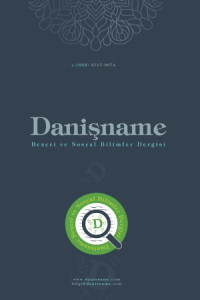KANT’TA SENTETİK A PRİORİ’NİN MATEMATİĞİN GERÇEKLİĞİNDEKİ ROLÜ
Modern dönem filozoflarının başlıca hedeflerinden biri yükselmekte olan doğa bilimlerine ve ayrıca bu bilimlerin hem doğa tasvirine hem de doğayı araştırma yöntemlerine genel felsefi bir zemin sağlamaktı. Galileo ile başlayan ve Newton ile büyük bir gelişme gösteren doğal bilimlerin nicelikselleştirilmesi sürecinde evren matematik diliyle tasvir edilmeye başlamıştı. Ancak bu tasvirin kavramsal temellerinde bazı sorunlar vardı. Bu sorunları fark eden Kant, Newton’un evren izahının önemini ve kıymetini takdir etmekle birlikte söz konusu kavramsal problemler giderilmediğinde bu muazzam binanın çürük temeller üzerinde eğreti bir yapıdan öteye gitmeyeceğini öngördü. Bu amaçla Kant, fizik evrenin dili olmayı amaçlayan soyut ve tümellerin evreni olan matematik ile somut ve tikellerin evreni olan fizik evren arasındaki “örtük olmama” problemini “sentetik a priori” tezi ile çözerek gerçekleştirmiştir. Bu çalışmada Kant’ın, somut ve olgusal olan fizik evren ilkelerinin soyut, değişmeyen ve tümellerin âlemi olan matematik dili tarafından temsilini imkân dâhilinde olmasını sağlayan “sentetik a priori” tezinin kavramsal ve mantıksal olarak nasıl ispatlandığı araştırılacaktır.
Anahtar Kelimeler:
Matematik Felsefesi, Kant’ın Sentetik a Priori Tezi, felsefe
THE ROLE OF SYNTHETIC A PRIORI IN KANT IN THE REALITY OF MATHEMATICS
One of the main goals of modern-era philosophers was to provide a general philosophical basis for the emerging natural sciences, as well as for both their depiction of nature and their research methods. One of the basic criteria that made us understand the universe in the history of natural sciences has been the concept of quantity. Number quantity is the symbol or concept of quantities that can be measured quantitatively corresponding to these sizes in our minds. In this form of expression, since the qualitative properties of the object, which we perceive with our senses such as color, size (big / small), temperature, etc., are isolated by its concept of quantity, the object itself is now out of the question and the subject is discussed about the object only through numerical data. It is at this point that the problem of quantifying the expression of natural sciences began. In the process of quantitating natural sciences, which started with Galileo and showed a great improvement with Newton, the universe began to be described with the language of mathematics. However, there were some problems with the conceptual foundations of this depiction. Realizing these problems, Kant appreciated the importance and value of Newton’s explanation of the universe, but predicted that if these conceptual problems were not resolved, this enormous building would go beyond a makeshift structure on rotten foundations. Kant had identified two basic problems to be solved: i. While nature is the domain of experimental and non-essential knowledge, mathematics is the domain of rational, theoretical and compulsory knowledge. How can mathematics, which is a priori, in other words, which has universal and compulsory judgments, be applied to an empirical and therefore possible field, namely nature? ii. Newton’s concept universe is a universe in which the subject (mind) revolves around the object. Space and time, which are the most basic concepts of the universe imagination, are, according to Newton, real entities independent of things. In this case, does the mind not change or transform at all while receiving or grasping the object? If the subjects who knows what makes experience possible, are there no subjective conditions of it?
___
- Beck, L. W. (1992). Can Kant’s Synthetic Judgements be made Analiytic?, Ummanuel Kant:Critical Assessments. R.F. Chadwick, C. Cazeaux Ed. Vol. II. 347-362. New York: Routledge.
- Beiser, F. C. (1987). The Fate of Reason. England: Harvard University Press. Coffa, J. A. (1991). The Semantic Tradition From Kant to Carnap. Cambridge: Cambridge University Press.
- Çitil, A. (2000). Kant’m Transandantal Düşüncesinde Nesne Kuramı ve Bu Kuramın Derinleştirilmesinin Yol Açtığı Bazı Sorunlar. (Yayınlanmamış Doktora Tezi). Boğaziçi Üniversitesi, İstanbul.
- Descartes, R., (1999). Discourse on Method and Related Writings. (Çev. Desmond M. Clarke). Penguin Books.
- Dursun, Y. (2015). Felsefe ve Matematikte Analitik/Sentetik Ayırımı. Ankara: İmge Yayınevi.
- Frege, G. (1968). The Foundations of Arithmetic (İng. çev. J. L. Austin). 2. Baskı. Evanston, İL: Northwestern University Press.
- Friedman, M. (2011). Kant ve Kesin Bilimler. (Çev. Sibel Şan Öget). İstanbul: Alfa Basım Yayım Dağıtım San. Ve Tic. Ltd. Şti.
- Gödel, K. (1936). Über die Länge der Beweise, Ergeb, eines math. Kolloquiums 7: 23–24.
- Hume, D. (1993). An Enquiry Concerning Human Understanding. 2. Baskı. E. Steinberg (Ed.). Indianapolis: Hackett Publishing Company.
- Jones, E. (1989). Reading the Book of Nature. Atina: Ohio University Press. Kant, I. (1965). Critique of Pure Reason. (İng. çev. N. K. Smith). New York: St Martin’s Press.
- Kant, I. (1996). Prolegomena To Any Future Metaphysics That Can Qualify as a Science. (İng. çev. P. Carus). 13 Baskı. Chicago: Open Court.
- Koç, Y. (1994). Mekân ve Nesne. İstanbul: Felsefe Arkivi 29.
- Koç, Y. (1996). Matematiğin Ontoloji Bakımından Kant ile Frege Karşılaştırması. İstanbul: Felsefe Arkivi 35.
- Leibniz, G. W. (1989). Philosophical Essays. (İng. çev. R. Anew ve D. Garber). Indianapolis: Hackett Publishing Company.
- Platon, (2006). Devlet. (Çev. Sabahttin Eyüpoğlu-M. Ali Cimcoz). İstanbul: İş Bankası Kültür Yayınları.
- Sasaki, C. (2003). Descartes Mathematical Tought. Kluwer Academic Publishers.
- Wild, J. Coblitz, J.L. (1948). On Distinction Between the Analytic and Synthetic. Philosophy and Phenomenological Research Vol. 8, Issue 4, 651-667.
- Wood, W., Allen. (2005). Kant (Çev. Aliye Kovanlıkaya). İstanbul: Alfa Basım Yayım Dağıtım San. Ve Tic. Ltd. Şti.,
- Yalçın, Ş. (2003). Kant’ta Matematiğin Felsefi Temelleri. Felsefe Dünyası, 37(1).
- Başlangıç: 2020
- Yayıncı: Küresel Güvenlik ve Strateji Derneği
Sayıdaki Diğer Makaleler
KEMALPAŞAZÂDE’NİN İSBÂT-I VÂCİB YORUMU VE KATKISI
AHLÂK-I NÂSIRÎ VE AHLÂK-I ALÂÎ’NİN MUKAYESELİ KAYNAK ANALİZİ
ALMANYA’DA EVANJELİK DİN DERSİ ÖĞRETMENLİĞİ PROGRAMI VE TÜRK DİN GÖREVLİLERİ
İSLÂM YARGI SİSTEMİNE GÖRE DNA VE PARMAK İZİNİN DELİL OLMA DEĞERİ
KANT’TA SENTETİK A PRİORİ’NİN MATEMATİĞİN GERÇEKLİĞİNDEKİ ROLÜ
İBN KEMAL’İN BAZI METAFİZİK MESELELER KONUSUNDA CÜRCÂNÎ’YE YÖNELTTİĞİ ELEŞTİRİLER
KONFÜÇYÜSÇÜ AHLAK İLE İSLAM AHLAKININ MUKAYESESİ
İNSANIN CEZA VE MÜKÂFATI HAK ETMESİ BAĞLAMINDA EŞ‘ARÎ’NİN KESB KURAMI
